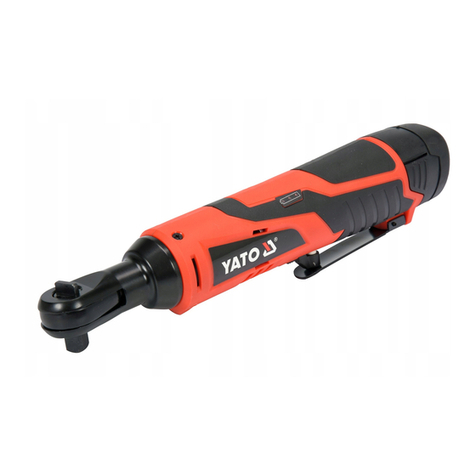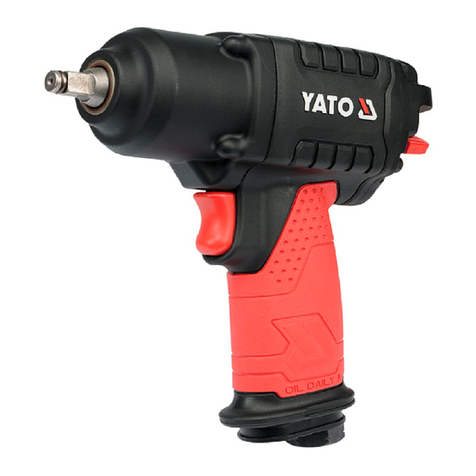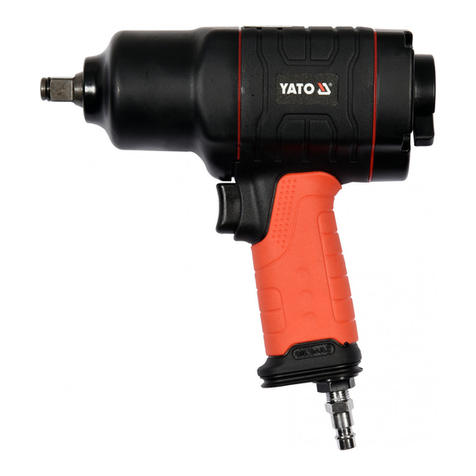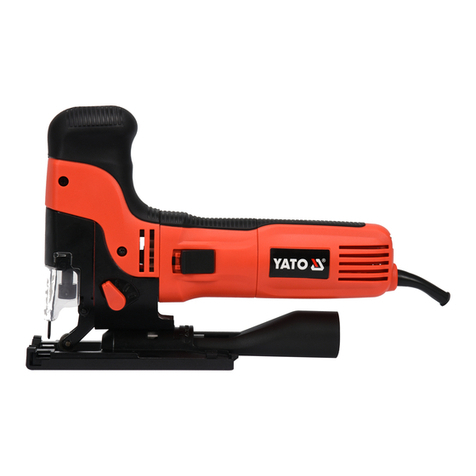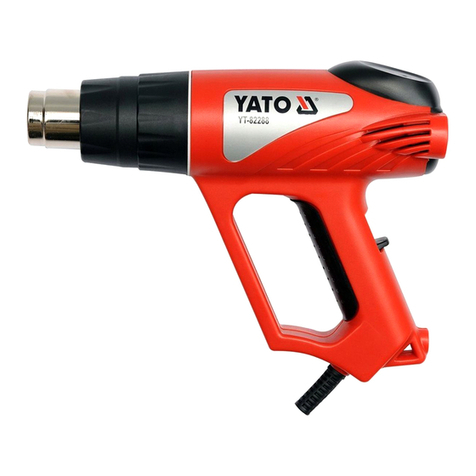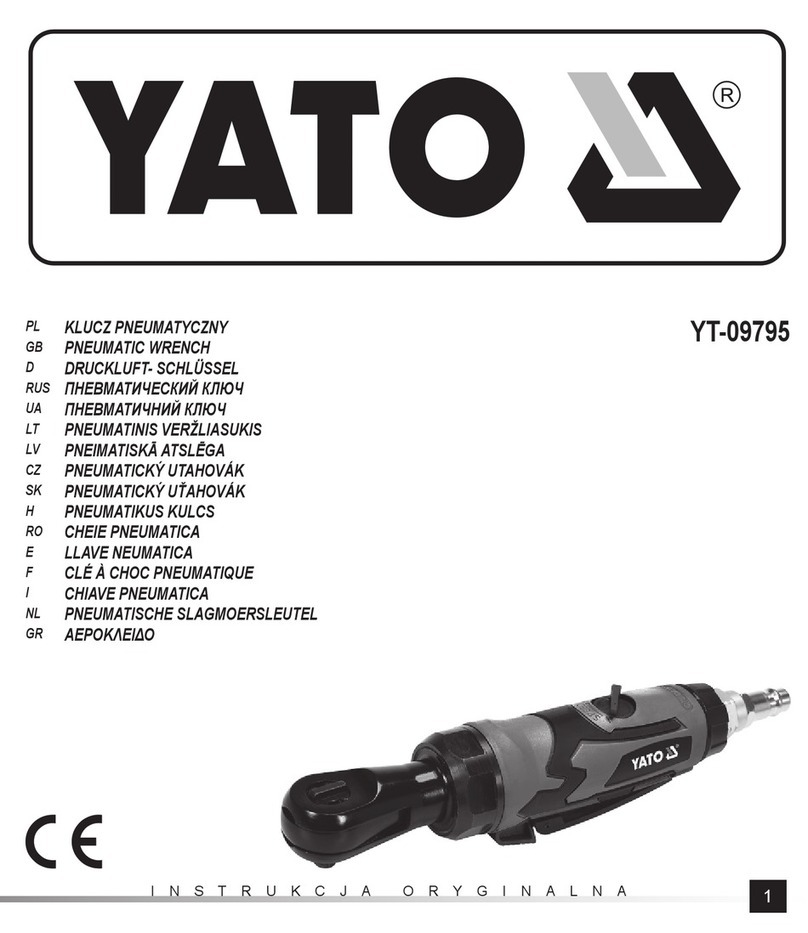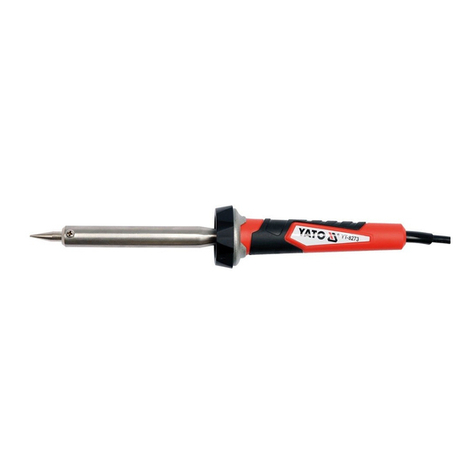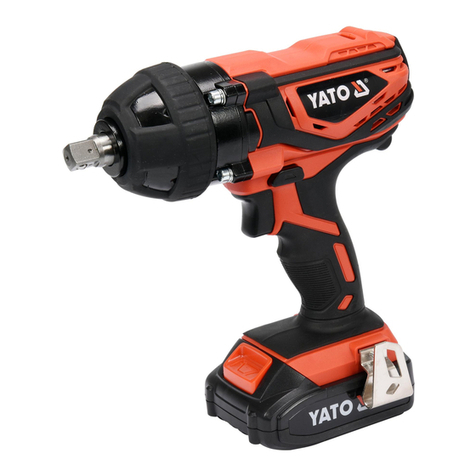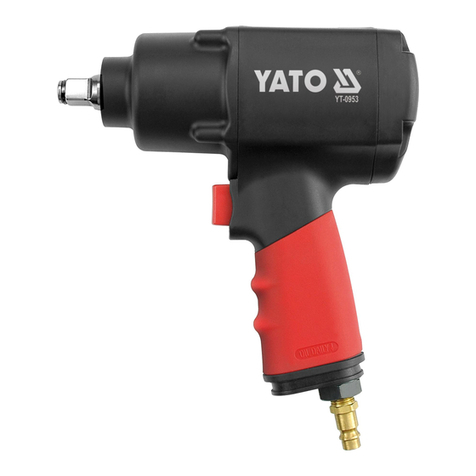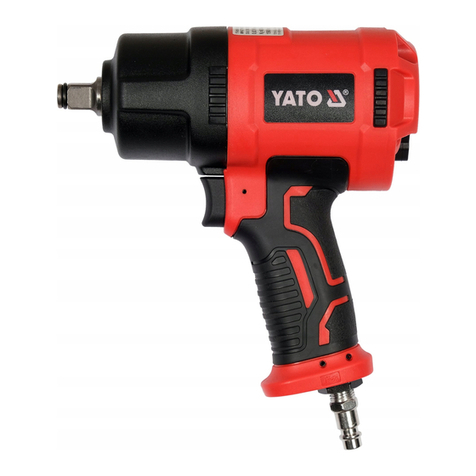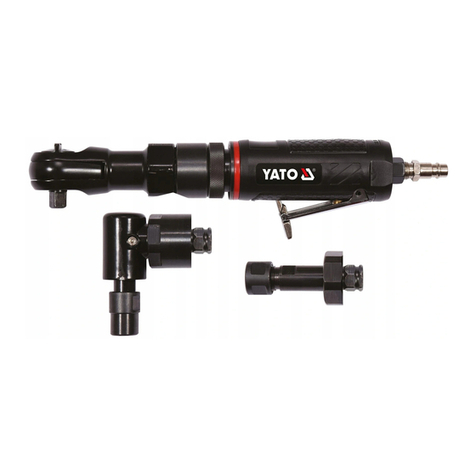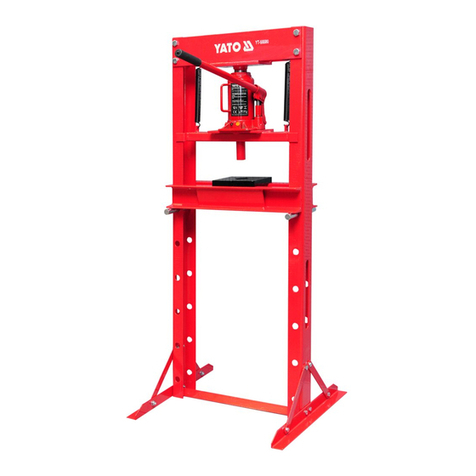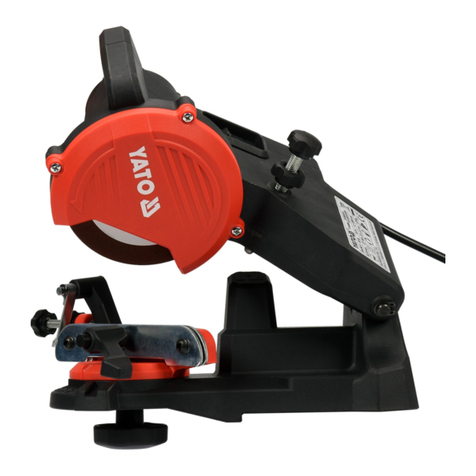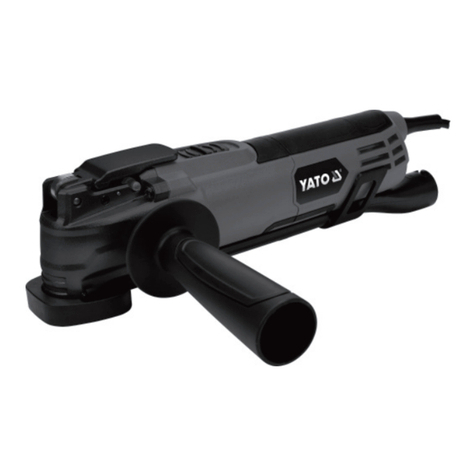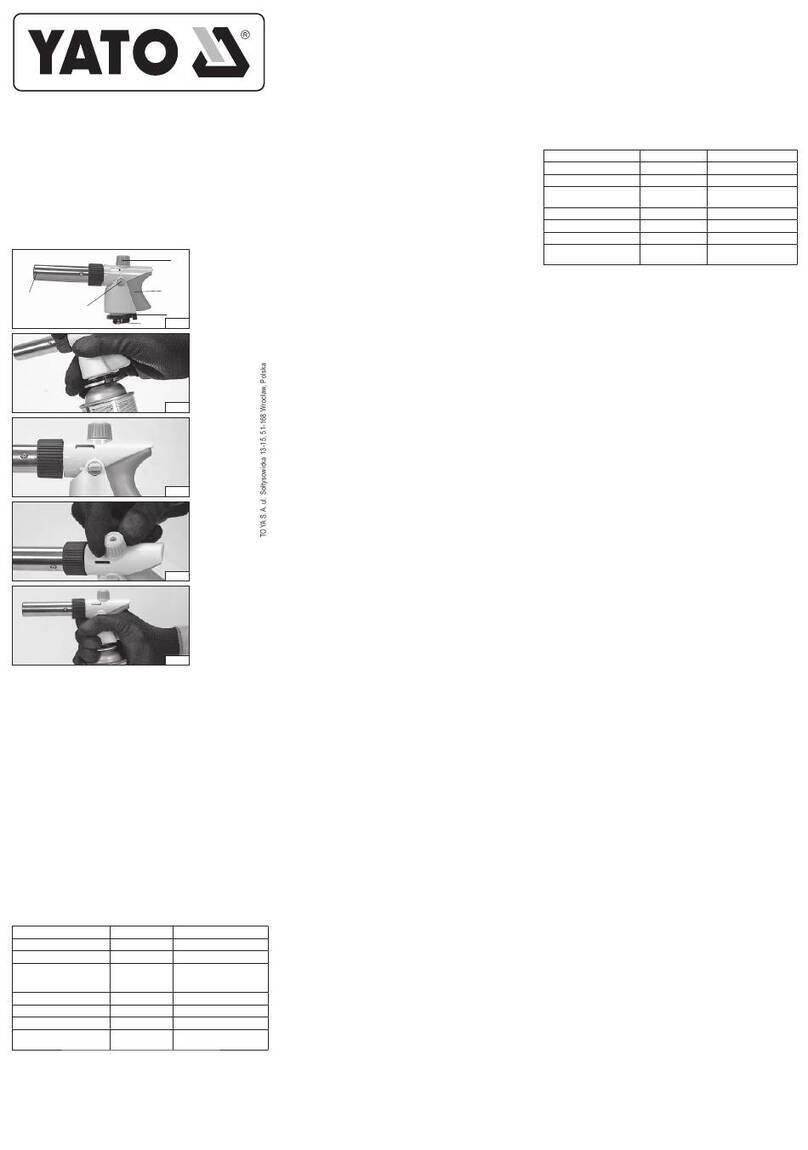YATO YT-2375 User manual

YT-2375
PL
PISTOLET DO PIASKOWANIA
SAND BLAST GUN
PL
GB
INSTRUKC JA ORYGINALNA
Przed przystąpieniem do eksploatacji niniejszego urządzenia przeczytaj całą instrukcjęi zachowaj ją.
ZASTOSOWANIE
Pistolet do piaskowania służy do oczyszczania powierzchni ze starych powłok lakierniczych, rdzy oraz innych zabrudzeńoraz do kształtowania powierzchni. Oczyszczanie odbywa sięza pomocą
strumienia sprężonego powietrza i materiału ściernego.
DANE TECHNICZNE
Nr katalogowy Pojemność zbiornika Ciśnienie robocze Maksymalne ciśnienie powietrza Maksymalne zużycie powietrza Poziom hałasu LwA (EN 14462) Drgania Masa
[l] [MPa] [MPa] [l/min.] [dB(A)] [m/s2] [kg]
YT-2375 - 0,2 - 0,5 0,8 160 ≤89 ≤2,03 0,45
ZALECENIA BEZPIECZEŃSTWA
Nigdy nie kierowaćwylotu narzędzia w kierunku ludzi - materiały powłokowe lub sprężone powietrze mogąbyćpowodem uszkodzeńciała i innych urazów.
Zabronione jest stosowanie jakichkolwiek innych gazów zamiast sprężonego powietrza. Zastosowanie innych gazów może prowadzićdo powstania poważnych obrażeń, spowodowaćpożar lub
grozićwybuchem.
Przy podłączaniu narzędzia do instalacji sprężonego powietrza należy braćpod uwagęprzestrzeńpotrzebnąna wąż, aby uniknąć uszkodzenia węża lub złączek.
Na stanowisku pracy powinna byćzapewniona skuteczna wentylacja. Brak skutecznej wentylacji może powodowaćzagrożenie zdrowia, spowodowaćpożar lub grozićwybuchem.
Narzędzie należy używaćz daleka od źródełciepła i ognia, ponieważmoże to spowodowaćjego uszkodzenie lub pogorszenie funkcjonowania.
Przestrzegaćogólnych zasad bezpieczeństwa przy wykonywaniu prac z materiałami powłokowymi i stosowaćodpowiednio dobrane środki ochrony osobistej takie jak gogle, maski i rękawice.
Nigdy nie zostawiaćzmontowanego układu pneumatycznego bez nadzoru osoby uprawnionej do obsługi. Nie dopuszczaćdzieci w pobliże zmontowanego układu pneumatycznego.
Zasilanie sprężonym powietrzem, pod wysokim ciśnieniem, może spowodowaćodrzut narzędzia w kierunku przeciwnym do kierunku wyrzucania materiału powłokowego. Należy zachowaćszczególna
ostrożność, gdyżsiły odrzutu mogą, w pewnych warunkach, spowodowaćwielokrotne zranienia.
Zaleca sięwypróbowaćnarzędzie przed rozpoczęciem pracy. Zaleca się, aby osoby pracujące narzędziem zostały odpowiednio przeszkolone. Zwiększy to znacząco bezpieczeństwo pracy.
Przestrzegaćzaleceńproducenta materiałów powłokowych i stosowaćje zgodnie z podanymi zasadami ochrony osobistej, przeciwpożarowej i ochrony środowiska. Nieprzestrzeganie zaleceńproducenta
materiałów powłokowych, może prowadzićdo poważnych obrażeń.
W celu stwierdzenia kompatybilności ze stosowanymi materiałami powłokowymi, wykaz materiałów użytych do konstrukcji narzędzia, będzie dostępny na żądanie.
Podczas pracy ze sprężonym powietrzem w całym układzie gromadzi sięenergia. Należy zachowaćostrożność, podczas pracy oraz przerw w pracy, aby uniknąć zagrożenia jakie może spowodować
zgromadzona energia sprężonego powietrza.
Nigdy nie kierowaćstrumienia materiału powłokowego na źródło ciepła bądźognia, może to spowodowaćpożar.
INSTRUKCJA UŻYTKOWANIA
Rozpoczęcie pracy
Upewnićsię, że nakrętka mocująca dyszęwylotowąpistoletu została dokręcona mocno i pewnie.
W przypadku pistoletu wyposażonego w zbiornik na materiałścierny, należy zbiornik napełnićmateriałem ściernym. Zamknąć pokrywęzbiornika, następnie zbiornik zamocowaćdo pistoletu. Nakrętkę
mocującązbiornika dokręcićza pomocąklucza.
W przypadku pistoletu wyposażonego wąż z dysząssącą, należy wąż zamocowaćdo pistoletu, a do drugiego końca węża dyszęssącą. Zaleca sięużycie opasek zaciskowych w celu poprawy mocowania
węża do przyłączy pistoletu i dyszy.
Dyszęssąca zanurzyćw pojemniku z materiałem ściernym, tak aby koniec rurki odpowietrzającej wystawałponad powierzchnięmateriału ściernego.
Sprawdzićszczelność i pewność połączeńukładu zasilającego sprężonego powietrza.
Przedmuchaćwąż zasilający powietrzem, przed podłączeniem go do instalacji.
Przed użyciem pistoletu upewnićsię, że zostałw odpowiedni sposób poddany czyszczeniu i konserwacji.
Wymiana dyszy wylotowej
Odłączyćpistolet od źródła zasilania sprężonym powietrzem. Odłączyćod pistoletu zbiornik lub wąż.
Odkręcićnakrętkęmocującądyszęwylotową. Oczyścićgwint pistoletu oraz nakrętki mocującej.
Zamontowaćnowądyszę, mocno i pewnie dokręcićnakrętkęmocującą.
Praca pistoletem
Wyregulowaćciśnienie w układzie pneumatycznym w taki sposób, aby nie przekroczyćmaksymalnego ciśnienia pracy pistoletu oraz nie uszkodzićczyszczonej powierzchni.
Skierowaćwylot dyszy w stronęczyszczonej powierzchni i nacisnąć język spustowy.
Podczas pracy pistoletem mogąwytworzyćsięduże ilości pyłu, dlatego należy bezwzględnie stosowaćśrodki ochrony osobistej, takie jak hełmy ochronne z doprowadzeniem powietrza, ochronęsłuchu
oraz odpowiedni strój ochronny.
Czyszczenie i konserwacja
Po skończonej pracy należy odłączyćpistolet od układu sprężonego powietrza i opróżnićzbiornik narzędzia z pozostałego materiału ściernego.
Oczyścićobudowępistoletu za pomocąszmatki wykonanej z miękkiego materiału. Dyszępistoletu przedmuchaćprzez kilka sekund czystym powietrzem, kierując jąw bezpieczne miejsce.
Starannie wyczyścićcały tor przesyłu materiału ściernego. Niedokładne wyczyszczenie może obniżyćparametry strumienia materiału ściernego.
Po oczyszczeniu pistoletu należy na części ruchome uszczelnieńnałożyćniewielkąilość środka smarującego.
12
3
4
9
8
7
6
71
PL
1. Dysza wylotowa
2. Nakrętka mocująca dyszę
3. Przyłącze powietrza
4. Język spustowy
5. Zbiornik
6. Wąż
7. Przyłącze węza
8. Dysza ssąca
9. Rurka odpowietrzająca
GB
1. Outlet nozzle
2. Nozzle securing nut
3. Air supply connection
4. Trigger
5. Tank
6. Hose
7. Hose connection
8. Suction nozzle
9. Deaeration pipe

Before operation of the device may commence, please read the whole manual and keep it.
PURPOSE
The purpose of the sand blast gun is to remove old lacquer coatings, rust and other dirt from surfaces, as well as to shape surfaces. Cleaning is realised by means of a compressed air jet and an abrasive
material.
TECHNICAL DATA
Catalogue number Tank capacity Operating pressure Maximum air pressure Maximum air consumption Noise level LwA (EN 14462) Vibrations Weight
[l] [MPa] [MPa] [l/min.] [dB(A)] [m/s2] [kg]
YT-2375 - 0,2 - 0,5 0,8 160 ≤89 ≤2,03 0,45
SAFETY MEASURES
Never should the spray gun nozzle mouth be directed towards people – the coating materials or the compressed air may cause injuries.
It is not permitted to use any other gas instead of compressed air. Application of other gases may cause serious injuries, a fire or an explosion.
Connecting the tool to the compressed air installation take into account the space required for the hose, in order to avoid possible damage to the hose or couplings.
There should be an efficient ventilation system at the workstation. Otherwise, there is a risk to health, as well as a risk of fire or an explosion.
The tool must be operated far from sources of heat and ignition, since otherwise there is a risk of damage to the tool or impairment of its functioning.
Observe general safety regulations during work with coating materials and use appropriate personal protection means, such as goggles, masks and gloves.
Never should an assembled pneumatic system be abandoned without supervision of an authorised operator. Do not allow children close to an assembled pneumatic system.
High-pressure compressed air may make the tool recoil in the direction opposite to the thrust of the coating material. Great caution should be exercised during work, since the thrust may, under certain
circumstances, cause multiple injuries.
It is recommended to test the tool before the work commences. It is recommended that the employees operating the tool be adequately trained. It will significantly increase their safety.
Observe the instructions and recommendations of the manufacturer of the coating materials and apply the materials in accordance with the specified regulations on personal protection, fire protection and
environmental protection. If the instructions and recommendations of the manufacturer of the coating materials are not observed, there is a risk of serious injuries.
If required, a list of materials used to manufacture the tool will be available in order to determine the compatibility with the applied coating materials.
During work with compressed air the whole system accumulates energy. Caution must be exercised during work and breaks, in order to eliminate the danger, which may be caused by the accumulated
energy of the compressed air.
Never should the coating material jet be directed towards a source of heat or ignition, since otherwise a risk of fire may arise.
OPERATION
Commencement of work
Make sure the sand blast gun outlet nozzle securing nut has been properly tightened.
If the sand blast gun is equipped with an abrasive material tank, fill the tank with abrasive material. Close the tank cover and attach the tank to the sand blast tank. The tank securing nut must be tightened
with a spanner.
If the sand blast gun is equipped with a suction nozzle hose, the hose must be connected to the sand blast gun, and the suction nozzle must be installed at the other end of the hose. It is recommended
to use band clips in order to ensure correct and secure installation of the hose on the sand blast gun and nozzle connections.
Immerse the suction nozzle in the abrasive material tank so that the deaeration pipe tip protrude above the surface of the abrasive material.
Check the connections of the compressed air system for tightness.
Blow the air supply hose before it is connected to the installation.
Before the sand blast gun is operated, make sure it has been cleaned and maintained properly.
Replacement of the outlet nozzle
Disconnect the sand blast gun from the compressed air supply. Disconnect the tank or the hose from the sand blast gun.
Remove the outlet nozzle securing nut. Clean the thread of the sand blast gun and the securing nut.
Install a new outlet nozzle and tighten properly the securing nut.
Work with the sand blast gun
Adjust the pressure in the pneumatic system not exceeding the maximum operating pressure for the sand blast gun so as not to damage the surface to be cleaned.
Direct the nozzle mouth towards the surface to be cleaned and press the trigger.
During work with the sand blast gun large quantities of dust may be generated, so it is necessary to use personal protection means, such as helmets with air supply, hearing protection and appropriate
protective clothing.
Cleaning and maintenance
Once the work has concluded, disconnect the sand blast gun from the compressed air system and remove the coating material remaining in the tank. Clean the enclosure with a soft cloth. Direct the
nozzle towards a safe place and blow it for a couple of seconds with clean air.
Clean thoroughly the whole route of the coating material. Careless cleaning will impair the parameters of the coating material jet. Once the sand blast gun has been cleaned, the movable elements of the
sealing must be coated with a small quantity of a lubricant.
TOYA S.A. ul. Sołtysowicka 13-15, 51-168 Wrocław, Polska
INSTRUKC JA ORYGINALNA
GB
Rok produkcji:
Production year:
2013
Table of contents
Languages:
Other YATO Power Tools manuals
